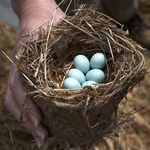- If you find a nest that appears to have been abandoned with eggs in it, do not to touch it! Chances are that the parent is off feeding somewhere.
- Waterfowl do not incubate their eggs until all their eggs have been laid. Thus, the nest is left unattended after each egg is laid. This often results in people claiming that they have just found an abandoned nest. Once the homeowner understands the differences between the nesting habits of various species, they will usually be happy to protect the nest from potential predators until the female is ready to incubate.
- If the nest is truly abandoned, there is always a good reason: parent has been killed, the nest was disturbed too often (nest above a front door), etc.
- If someone discovers a nest, say, over the front door (or any other area that is likely to be disturbed quite a bit), it is advised to either move the original nest or to install an artificial nest near the location (with a bit more privacy). However, before this occurs, the homeowner must call the local fish and wildlife office (because we are not supposed to touch nests at all!). Chances are that the office will give the caller verbal permission to relocate the nest as long as it is still available to the birds.
- If the incubation has been disturbed for a long period, the embryos are likely dead or at least irreversible damaged.
- If the homeowner has found a nest that has been damaged, use a margarine container (punch some holes in the bottom). Line the container with some of the old nesting materials (never use string) and replace it in a shady area as close as possible to the original nest site.
- The taking of nests or eggs is prohibited under the Migratory Bird Act and can be subject to fines or a jail term (depending on the severity of the offence):
- Corporation: up to $100,000 or up to $250,000.
- Individual: up to $50,000 or 6 months in jail or up to $100,000 or 5 years.
The birds included in the Act are as follows:
1. Migratory Game Birds:
- Waterfowl (anatidae): brants, wild ducks, geese, and swans.
- Cranes (gruidae): including little brown, sandhill, and whooping cranes.
- Rails (rallidae): including coots, gallinules, sora and other rails.
- Shorebirds (limicolae): including avocets, curlew, dowitchers, godwits, knots, oyster catchers, phalaropes, plovers, sandpipers, snipe, stilts, surf birds, turnstones, willet, woodcock, and yellowlegs.
- Pigeons (columbidae): including doves, rock doves and wild pigeons.
2. Migratory Insectivorous Birds:
Bobolinks, catbirds, chickadees, cuckoos, flickers, flycatchers, grosbeaks, humming birds, kinglets, martins, meadowlarks, nighthawks or bull bats, nuthatches, orioles, robins, shrikes, swallows, swifts, tanagers, titmice, thrushes, vireos, warblers, waxwings, whippoorwills, woodpeckers, and wrens, and all other perching birds which feed entirely or chiefly on insects.
3. Other Migratory Non-Game Birds:
Auks, auklets, bitterns, fulmars, gannets, grebes, guillemots, gulls, herons, jaegers, loons, murres, petrels, puffins, shearwaters, and terns.
If you have a nest that is posing a health hazard (nest in vents, etc.), contact a licensed service.

